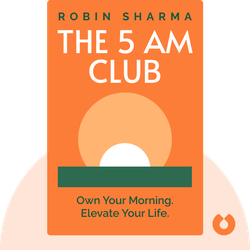Try Blinkist to get the key ideas from 7,000+ bestselling nonfiction titles and podcasts. Listen or read in just 15 minutes.
Start your free trial
Blink 3 of 8 - The 5 AM Club
by Robin Sharma

The Inside Story of the Oxford AstraZeneca Vaccine and the Race Against the Virus
Vaxxers by Sarah Gilbert and Catherine Green explains how vaccines work and why they are critical in fighting pandemics. It debunks vaccine myths and gives an insight into the life-saving impact of vaccines.
Coauthor Cath Green was staying at a campsite in northwestern Wales when she and her friend struck up conversation with a fellow camper. When Cath lamented the lack of cell phone signal, the camper expressed skepticism about the new 5G towers being installed around the UK – even though no associated health risks have been found.
At least, Cath’s friend joked, this person wasn’t saying that 5G caused COVID-19 or that Bill Gates was inserting microchips into everyone through vaccines.
The camper replied that actually, while there might not be a conspiracy, she didn’t know what went into these vaccines and she didn’t trust the people making them. She called these people them.
Little did she know that them meant Cath. She knew exactly what was in one of the soon-to-be approved vaccines. In fact, she was part of the research lab at the University of Oxford that had developed it.
The key message here is: Scientists were researching viral outbreaks and developing vaccines for years before COVID-19 was ever identified.
To people like that camper in Wales, it might seem like the COVID-19 vaccines were created too quickly and under mysterious circumstances. But the truth is that scientists were already preparing for something like COVID years before the first recorded case. The official name of the virus is SARS-CoV-2, and it’s neither the first coronavirus nor the first to cause SARS – that is, severe acute respiratory syndrome – in humans.
In November 2002, a previously unknown coronavirus – which came to be called SARS-CoV – was identified in a province in China. It caused pneumonia, and by the end of the outbreak in June 2003, 774 people had died. Public health efforts managed to contain the spread of infection through the traditionally effective methods of contact tracing and quarantine. There was no vaccine, and at the time, no demand for one. It was unclear if or when this coronavirus would return.
Coronaviruses are often found in bats, and most usually stay in bat populations, never reaching humans. With SARS, bats likely transmitted the virus to other mammals more commonly exposed to humans. That’s also what happened with the outbreak of Middle East respiratory syndrome, also known as MERS-CoV, in 2012. MERS was detected in camel populations in the Middle East, and spread to humans in close proximity to them by way of vapor droplets sent into the air when the camels breathed, sneezed, or coughed.
With each new outbreak, scientists and public health organizations learned more about which responses were most effective in containing viruses and which needed improvement.



Vaxxers (2021) follows the race to develop a functional vaccine to curb the spread of the COVID-19 virus. Professor Sarah Gilbert and Dr. Catherine Green, of the University of Oxford, deliver captivating and informative insight into the process of designing, testing, and manufacturing the Oxford-AstraZeneca vaccine in record time. They recount exciting moments of innovation, as well as the hurdles faced along the way.
Vaxxers (2021) by Sarah Gilbert and Catherine Green gives a fascinating behind-the-scenes look at the development of the Oxford-AstraZeneca COVID-19 vaccine. Here's why you should consider reading it:
It's highly addictive to get core insights on personally relevant topics without repetition or triviality. Added to that the apps ability to suggest kindred interests opens up a foundation of knowledge.
Great app. Good selection of book summaries you can read or listen to while commuting. Instead of scrolling through your social media news feed, this is a much better way to spend your spare time in my opinion.
Life changing. The concept of being able to grasp a book's main point in such a short time truly opens multiple opportunities to grow every area of your life at a faster rate.
Great app. Addicting. Perfect for wait times, morning coffee, evening before bed. Extremely well written, thorough, easy to use.
Try Blinkist to get the key ideas from 7,000+ bestselling nonfiction titles and podcasts. Listen or read in just 15 minutes.
Start your free trial
Blink 3 of 8 - The 5 AM Club
by Robin Sharma
What is the main message of Vaxxers?
Vaxxers explores the complexities of vaccines and their controversies in an objective and enlightening manner.
How long does it take to read Vaxxers?
The reading time for Vaxxers varies depending on the reader's speed, but the Blinkist summary can be read in just 10 minutes.
Is Vaxxers a good book? Is it worth reading?
Vaxxers is worth reading for its comprehensive examination of the vaccine landscape and the insights it provides.
Who is the author of Vaxxers?
Sarah Gilbert and Catherine Green are the authors of Vaxxers.